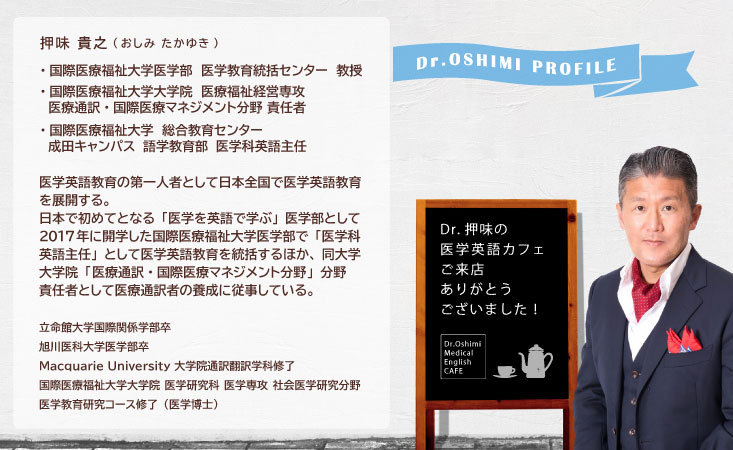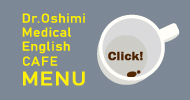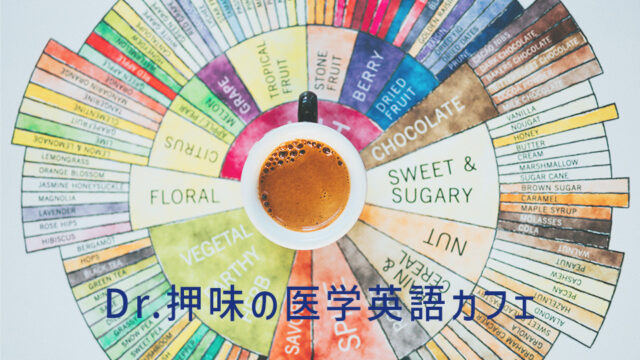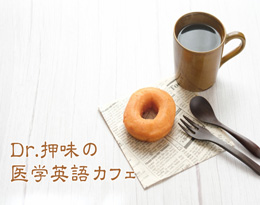
こんにちは。「医学英語カフェ」にようこそ!
ここは「コーヒー1杯分」の時間で、医学英語にまつわる話を気軽に楽しんでいただくコーナーです。
本日のテーマは「英語での症例プレゼンテーション:中級編」。
医療における英語の重要性が高まる中、海外での臨床実習ではもちろん、日本国内においても「英語での症例プレゼンテーション」Oral Case Presentation の機会が増えています。しかし日本の医学部では英語での症例プレゼンテーションの方法を系統的に学ぶ機会はそう多くはありません。
そこで今月は「Menu 30英語での症例プレゼンテーション:基礎編」に引き続き、日本の医学生によくある間違いと、英語での症例プレゼンテーションの基本的な定型表現をご紹介したいと思います。
日本の医学生によくある間違い
Menu 30 でも紹介したように、英語での症例プレゼンテーションに関して何も予備知識のない医学生の症例プレゼンテーションには下記のような特徴があります。
• 系統立っていない
• 鑑別疾患が想起されない
• 英語表現が拙い
ですからまずは Menu 30 で、下記の三つのポイントを確認してください。
• Structure: 英語症例プレゼンテーションの「型」を守る
• Argument: 鑑別診断を「議論」するために必要十分な情報を提供する
• Delivery: 英語症例プレゼンテーションに特有の「定型表現」を使う
これら三つのポイントを意識した症例プレゼンテーションができる段階を「初級」と定義します。しかしこれらのポイントを意識しても、日本の医学生には下記のような間違いがよく見られます。
• 「聴衆の視点」を欠いている
• 「現病歴」の情報が不足している
• 「現病歴」の記述が機械的である
• 「陰性となる関連項目」を述べていない
• 複数形や時制を正しく使っていない
• 一般英語と医学英語を正しく使い分けていない
• 薬剤名・バイタルサイン・検査などを具体的に述べていない
「中級」となるためにはこれらを意識して準備する必要があります。ではこれらのよくある間違いを一つずつ見ていきましょう。
「聴衆の視点」を欠いている
「初級」の段階では症例プレゼンテーションの準備をするだけで精一杯で、「その症例プレゼンテーションを自分が聴いても理解できるか?」という視点を欠いています。ある程度準備ができたら「その症例プレゼンテーションを自分が臨床現場で聴く」ということを想像してみましょう。もしも「自分が聴いても鑑別疾患が想起されない」というものであれば、上記に紹介した Structure, Argument, and/or Delivery のどこかに問題があるということです。「自分が聴いても理解できない」という症例プレゼンテーションは、他の人にも理解できません。まずは「聴衆の視点」を持って自分の症例プレゼンテーションを批判的に見てみましょう。
「現病歴」の情報が不足している
日本の臨床現場では検査の重要性が強調されているためか、日本の医学生が行う症例プレゼンテーションでは「医療面接・病歴聴取」History Taking が軽視される傾向があります。しかし英語での症例プレゼンテーションにおいて最重要項目は「現病歴」History of Present Illness (HPI) と言えます。英語での症例プレゼンテーションでは HPI が History Taking の半分以上(少なくとも3分の1以上)となるのが一般的であるということを認識してください。
「現病歴」の記述が機械的である
次に多い間違いが、この HPI をOPQRST (Onset, Provoking & Palliating Factors, Quality, Region & Radiation, Severity, and Timing) などの「語呂合わせ」 mnemonics の項目を使って「機械的」に述べるということです。なぜそれが良くないかというと、それが聴衆にとって鑑別の助けとならないことが多いからです。
上述したように HPI はHistory Taking にとって最も重要です。と言うのも適切な HPI によって診断が可能となる場合が多いからです。例えば「冠動脈疾患」coronary artery diseases である「心筋梗塞」myocardial infarction や「安定狭心症」stable angina pectoris、「不安定狭心症」unstable myocardial infarction、そして「異型狭心症」variant angina pectoris などは、適切な HPI だけで診断がある程度想起されます。こういった鑑別疾患を意識せずにただ「機械的」に OPQRST を項目順に述べられても聴いている方は鑑別疾患を想起することはできません。
ですからHPI では OPQRST などを項目順に述べるのではなく、“Draw the picture of the patient’s story” ということを意識して、「発症前」「発症時」「発症後」のように時系列で症状の変化を述べていきましょう。OPQRST の項目に関する情報は、この時系列で述べていく中で鑑別疾患を意識して述べることを心がけてください。
「陰性となる関連項目」を述べていない
症例プレゼンテーションでは、指導医も含めて聴衆全員が頭の中で診断を行いながら聴いています。従って聴衆の医師や医学生全員が納得して診断に到達できるのが良い症例プレゼンテーションと言えます。
そのためには「陽性となる関連項目」pertinent positives と「陰性となる関連項目」pertinent negatives を述べる必要があるのですが、これらの両方、特に pertinent negatives を述べない医学生が多いのです。
たとえば患者さんの主訴が chest pain で、その診断が myocardial infarction であったとしましょう。そして myocardial infarction には chest pain 以外にも、「呼吸困難」 dyspnea や「吐き気」 nausea のような関連症状がありますので、それが認められる場合には pertinent positives として、そしてたとえそれらが認められなくても pertinent negatives として述べていく必要があります。また myocardial infarction 以外の鑑別疾患である「肺炎」pneumonia には、「咳」cough や「痰」sputum といった関連症状があります。そしてこういった関連症状が認められない場合にも、それらを pertinent negatives として述べていく必要があるのです。
聴衆である指導医や他の医学生から追加の質問をされないのが良い症例プレゼンテーションの条件です。自分が考える診断や鑑別疾患では主訴以外にどのような症状やリスクファクターがあるのかを考え、それらが認められる場合には pertinent positives として、そして認められない場合には pertinent negatives として述べるようにしてください。
複数形や時制を正しく使っていない
複数形や時制も多くの学生さんは間違って使っています。
下記の表現は全て間違いなのですが、皆さんは正しい表現がわかりますか?
• The patient is a 48-years-old woman, who presented with two-hours-history
of intermittent chest pain.
• His vital sign is within normal limit.
• His weight was 67 kilogram.
複数の名詞をハイフンで繋げて形容詞とする場合、それぞれの名詞は単数形にする必要があります。したがって “48-years-old woman” や “two-hours-history” ではなく、 “48-year-old woman” や “two-hour-history” とする必要があります。
日本語にもなっている「バイタルサイン」ですが、これには複数の項目が含まれるので、英語では vital signs のように必ず複数形になります。また「正常範囲内」は upper limit とlower limit という二つの limits の間にあるわけですから、within normal limits のように必ず複数形になります。そしてこの withing normal limits (WNL) は「数値」に対して使える表現ですので、画像検査などに “The chest X-ray is within normal limits.” のように使うことはできません。正しくは “The chest X-ray is unremarkable for pathology.” のように表現します。
また英語の単位は数字が1以外の場合、必ず複数形になります。従って「1キログラム」は英語では one kilogram となりますが、「67キログラム」は sixty seven kilograms のように複数形になります。
身体診察の所見を述べる場合に「身体診察をしたのは過去なのだから過去形を使うべきだ」という理屈は理解できるのですが、これらを過去形で表現すると「今の身体所見はその時の所見とは違う」というイメージを与えてしまいます。ですから「身体診察をしたのは過去だが、今もその身体所見は変わっていない」という場合には、 “His weight is 67 kilograms.” のように現在形を使うのが一般的です。
一般英語と医学英語を正しく使い分けていない
これに関しては絶対的な基準があるわけではありませんが、「主訴」Chief Complaint や「現病歴」History of Present Illness においては患者さんが使った表現を一般英語でそのまま使うことが一般的です。「力が弱い」weakness という症状が主訴である場合、その weakness が neurological weakness なのか functional weakness なのかの区別を現病歴で記述する必要があります。「筋力低下の医学英語は paresis なのだから、主訴や現病歴でも paresisという医学英語を使う」ということをしてしまうと、それを聴いている聴衆は間違った前提で鑑別診断を進める可能性があります。
こういったことを防ぐため、「既往歴」Past Medical History 以降の項目では医学英語を使うべきですが、Chief Complaint とHistory of Present Illness においては患者さんが使った表現をそのまま一般英語として使うことを心がけてください。
薬剤名・バイタルサイン・検査などを具体的に述べていない
最後に指摘しておきたいよくある間違いは、「薬剤名」「バイタルサイン」「検査」などを具体的に述べていないということです。
「薬」Medications の項目で “Medications: The patient is currently on antihypertensives.” のような曖昧な記述は症例プレゼンテーションでは不十分です。「降圧剤」antihypertensive であるならば、その降圧剤の薬剤名を具体的に述べることが必要です。
「バイタルサイン」Vital Signs も “The vital signs are within normal limits.” のように述べることは避けましょう。英語では “Vital signs are vital.” という表現があるように、vital signs はそれぞれの項目に重要な意味があります。たとえ正常であったとしても vital signs はそれぞれの項目を具体的に述べるようにしてください。
そして「検査」Workup でもそれぞれの項目を具体的に述べるようにしましょう。よく「血液検査」という意味で Blood Tests(これは必ず複数形です)という表現を使う学生さんがいますが、これは曖昧すぎる表現です。どのような血液検査をしたいのか、具体的に下記のような項目を述べることが必要です。
• 全血算:Complete Blood Count (CBC)/Full Blood Count (FBC)
• 生化学検査:Blood Chemistry Tests
• 肝機能検査:Liver Function Tests (LFT)/Liver Panel/Liver Enzymes
• 凝固検査:Coagulation Tests/Coagulations Panel
• 動脈血ガス分析:Arterial Blood Gas (ABG)
これまで多くの学生さんの症例プレゼンテーションを指導してきましたが、これらが代表的な間違いです。「基礎」編で紹介した内容に加えてこれら「よくある間違い」を意識すれば、英語での症例プレゼンテーションにおいて「中級」と呼べるレベルに到達することができるでしょう。
英語での症例プレゼンテーションの定型表現
さて、そろそろカップのコーヒーも残りわずかです。最後に「英語での症例プレゼンテーションの定型表現」として基本的なものだけをまとめておきます。もちろんこれが全てではありませんので、First Aid for the USMLE Step 2 CS などの英語圏の医学教材も参照してください。
1. Patient Information
• The patient is a/an (age)-year-old (man/woman) with (pertinent risk factors),
who presented with a (duration)-history of (chief complaint).
2. History Taking
History of Present Illness (HPI)
Onset
• The patient had been in her/his usual state of health until ( )
days/weeks/months prior to the presentation, when she/he noticed ( ).
Provoking & Palliating Factors
• The (symptom) is aggravated by ( ).
• The (symptom) is alleviated by ( ).
Quality
• The patient describes the pain as ( ).
Region & Radiation
• The pain is located in ( ).
• The pain is localized in ( ) and does not move anywhere else.
• The pain is located in ( ) and moves to ( ).
Severity
• The patient rates the pain as ( ) out of 10.
• The pain was initially rated as ( ) out of 10, but it progressed to ( ) out of 10
over ( ) minutes.
Time
• The pain lasted for ( ) minutes.
Past Medical History (PMH)
• Her/His past medical history is unremarkable/noncontributory.
• Her/His past medical history is significant/remarkable for ( ) years of
(disease).
• Besides a ( )-year history of ( ), her/his past medical history is
unremarkable/noncontributory.
• The patient was hospitalized for (disease) ( ) at the age of ( ).
Past Surgical History (PSH)
• The patient underwent ( ) at the age of ( ).
Medications (Meds)
• She/He is currently on ( ) milligrams per day of ( ).
• The patient takes no medications or nutritional supplements.
Allergies
• The patient has known allergies to ( ), and it caused ( ).
• The patient has no known allergies (NKA).
• The patient has no known drug allergies (NKDA).
Family History (FH)
• Her/His family history is significant/remarkable for ( ) in her/his
(family member).
• Her/His family history is unremarkable/noncontributory.
• Her/His parents are alive and well.
• Her/His maternal/paternal grandmother/grandfather died of ( ) at the
age of ( ).
Social History (SH)
• The patient is married and lives with her/his husband/wife and her/his
child/children.
• The patient works as a ( ).
• The patient does not drink alcohol.
• The patient drinks ( ) milliliters of ( ) per day.
• The patient drinks ( ) glass(es) of ( ) on a social basis.
• The patient has had ( ) can(s) of ( ) per day for the past ( ) years.
• The patient has smoked ( ) packs of cigarettes per day for the past ( )
years.
• The patient has smoked one pack per day (PPD) for ( ) years.
• The patient has a ( ) pack-year history of smoking.
• The patient does not smoke.
Review of Systems (ROS)
• Review of systems is negative except as mentioned in the history of present
illness.
3. Physical Examination (PE)
Vital Signs
• Her/his temperature is ( ) degrees Celsius.
• Her/his blood pressure is ( ) over ( ) millimeters of mercury.
• Her/his heart rate is ( ) per minute with a sinus rhythm.
• Her/his respiratory rate is ( ) per minute.
• Her/his oxygen saturation is ( ) percent on room air.
General Appearance (GA)
• The patient is in acute distress.
• The patient is in no acute distress (NAD).
• She/He is well developed and well nourished. (Pediatrics)
Mental Status (Mental)
• She/He is alert, awake, and oriented times four (AAOx4).
• She/He is alert, awake, and oriented to name, place, time, and purpose.
Head, Eyes, Ears, Nose and Throat (HEENT)
• The head is normocephalic and atraumatic (NC/AT).
• The extraocular muscles are intact (EOMI) bilaterally (b/l).
• The pupils are equal and round, react to light and accommodation (PERRLA)
bilaterally (b/l).
• No conjunctival pallor.
• No conjunctival icterus.
• The bilateral (b/l) tympanic membranes (TM) are intact.
• The mucous membranes are moist (MMM).
• The neck is supple.
• No jugular venous distention (JVD)
• No cervical lymphadenopathy (LAD)
• No carotid bruits
• No goiter
Cardiovascular (CV)
• Regular rate and rhythm (RRR)
• Normal S1 and S2
• No murmurs, rubs, or gallops (m/r/g)
• Point of maximal intensity (PMI) is not displaced or not sustained.
• Apical impulse is not displaced.
• No hepatojugular reflux (HJR)
• Capillary refill time (CRT) is less than 2 seconds.
Pulmonary Exam (Chest)
• Clear to auscultation bilaterally (CTAB)
• No wheezes, rhonchi, or crackles (w/r/c)
• No egophony
• No tactile fremitus
• Resonant to percussion
Abdominal Exam (Abdomen)
• Soft
• Non-distended
• Non-tender
• No rebound or guarding
• No pulsatile masses
• Positive bowel sounds in all four quadrants
• No high pitched or tinkling sounds
• Resonant to percussion
• No costovertebral angle (CVA) tenderness
• No hepatosplenomegaly (HSM)
Neurological Exam (Neuro)
• Cranial Nerve (CN) II through XII are intact.
• No focal deficit
• Deep tendon reflexes: symmetric 2+ in all extremities
• Sensation: intact to pinprick and soft touch
• Manual muscle test (MMT): 5 out of 5
Extremities (EXT)
• Normal range of motion (ROM)
• No joint swelling or erythema
• No cyanosis
• No clubbing
• No edema
Skin
• Intact
• No lesions
• Macule/Patch/Papule/Plaque/Nodule/Pustule/Vesicle/Bulla
4. Summary
• In summary, the patient is a/an (age)-year-old (man/woman) with (pertinent
risk factors), who presented with a (duration)-history of (chief complaint +
significant HPI), associated with (pertinent positives).
5. Differential Diagnosis
• My list of differential diagnoses includes (#1 diagnosis), (#2 diagnosis), and
(#3 diagnosis).
• My top differential diagnosis at this time would be (#1 diagnosis), because…
• (#2 diagnosis) is a diagnosis we would need to consider, because…
• (#3 diagnosis) is a diagnosis we would need to exclude, because…
6. Plan
• I would like to order ( ), because…
では、またのご来店をお待ちしております。
「Dr. 押味の医学英語カフェ」では皆さんから扱って欲しいトピックを募集いたします。こちらのリンクからこのカフェで扱って欲しいと思う医学英語のトピックをご自由に記載ください。
国際医療福祉大学医学部 医学教育統括センター 教授 押味 貴之










